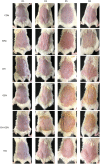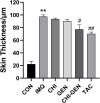Gentiopicroside-Loaded Chitosan Nanoparticles Inhibit TNF-α-Induced Proliferation and Inflammatory Response in HaCaT Keratinocytes and Ameliorate Imiquimod-Induced Dermatitis Lesions in Mice
- PMID: 37457802
- PMCID: PMC10348341
- DOI: 10.2147/IJN.S406649
Gentiopicroside-Loaded Chitosan Nanoparticles Inhibit TNF-α-Induced Proliferation and Inflammatory Response in HaCaT Keratinocytes and Ameliorate Imiquimod-Induced Dermatitis Lesions in Mice
Abstract
Purpose: In this study, we aimed to report the biological characteristics of the first successful synthesis of gentiopicroside-loaded chitosan nanoparticles and to evaluate the therapeutic effects and preliminary mechanisms of gentiopicrin-loaded chitosan on psoriasis-like cell and mouse models.
Methods: Gentiopicroside-loaded chitosan nanoparticles (CHI-GEN) were prepared, and their biological characteristics were evaluated. HaCaT keratinocytes were stimulated with TNF-α to establish a psoriatic keratinocyte model. MTT assay and flow cytometry were used to measure cell viability and apoptosis, respectively. mRNA levels of K17, VEGF A, and IL-6 and IL-23A were detected using qRT-PCR. These tests were used to preliminarily assess the effects of CHI-GEN on keratinocyte proliferation and inflammation. Imiquimod was used to construct a psoriasis-like mice model. The severity of psoriasis was scored based on the psoriasis area severity index (PASI), H&E staining was used to observe the histological changes and the level of inflammation and cell proliferation of skin lesions was evaluated by measuring the mRNA levels of K17, IL-23A, and IL-17A using qRT-PCR.
Results: The average particle size of CHI-GEN nanoparticles was approximately 100 nm, and the zeta potential was 2.69 ± 0.87 mV. The cumulative release was 67.2% in solutions of pH 5.5 at 24 h. GEN reduced TNF-α-induced excessive proliferation of HaCaT keratinocytes and downregulated mRNA levels of K17, VEGF A, and inflammatory cytokines IL-6 and IL-23A, which was more obvious in the CHI-GEN treatment group. Additionally, CHI-GEN significantly improved the severity of skin lesions in psoriasis-like mice and downregulated the mRNA expressions of IL-6, IL-23A, and IL-17A in mice skin lesions.
Conclusion: In conclusion, we successfully prepared gentiopicrin-chitosan nanoparticles. Our results show that these nanoparticles have anti-psoriasis activity, inhibits keratinocyte proliferation and improves symptoms in psoriasis model mice and can be used to develop an effective strategy for the treatment of psoriasis.
Keywords: chitosan; chitosan-loaded nano cream for external use; gentiopicroside; nanoparticles; proliferation and inflammation; psoriasis.
© 2023 Zhao et al.
Conflict of interest statement
The authors report no conflicts of interest in this work.
Figures


















Similar articles
-
Daphnetin inhibits proliferation and inflammatory response in human HaCaT keratinocytes and ameliorates imiquimod-induced psoriasis-like skin lesion in mice.Biol Res. 2020 Oct 20;53(1):48. doi: 10.1186/s40659-020-00316-0. Biol Res. 2020. PMID: 33081840 Free PMC article.
-
Eupatilin inhibits keratinocyte proliferation and ameliorates imiquimod-induced psoriasis-like skin lesions in mice via the p38 MAPK/NF-κB signaling pathway.Immunopharmacol Immunotoxicol. 2023 Apr;45(2):133-139. doi: 10.1080/08923973.2022.2121928. Epub 2022 Oct 28. Immunopharmacol Immunotoxicol. 2023. PMID: 36305632
-
Dang-Gui-Liu-Huang Tang a traditional herbal formula, ameliorates imiquimod-induced psoriasis-like skin inflammation in mice by inhibiting IL-22 production.Phytomedicine. 2018 Aug 1;47:48-57. doi: 10.1016/j.phymed.2018.04.051. Epub 2018 May 9. Phytomedicine. 2018. PMID: 30166108
-
Vascular Endothelial Growth Factor A VEGFA Inhibition: An Effective Treatment Strategy for Psoriasis.Int J Mol Sci. 2023 Dec 20;25(1):59. doi: 10.3390/ijms25010059. Int J Mol Sci. 2023. PMID: 38203230 Free PMC article. Review.
-
Targeted siRNA Therapy for Psoriasis: Translating Preclinical Potential into Clinical Treatments.Immunotargets Ther. 2024 May 16;13:259-271. doi: 10.2147/ITT.S458800. eCollection 2024. Immunotargets Ther. 2024. PMID: 38770264 Free PMC article. Review.
Cited by
-
A drug delivery perspective on nanotechnology-based topical therapeutics for inflammatory skin diseases.Nanomedicine (Lond). 2025 Jun;20(12):1441-1459. doi: 10.1080/17435889.2025.2506347. Epub 2025 May 25. Nanomedicine (Lond). 2025. PMID: 40415475 Review.
-
Evaluation of the Potential of Chitosan Nanoparticles as a Delivery Vehicle for Gentamicin for the Treatment of Osteomyelitis.Antibiotics (Basel). 2024 Feb 22;13(3):208. doi: 10.3390/antibiotics13030208. Antibiotics (Basel). 2024. PMID: 38534643 Free PMC article.
-
Molybdenum Nanoparticles Alleviate MC903-Induced Atopic Dermatitis-Like Symptoms in Mice by Modulating the ROS-Mediated NF-κB and Nrf2 /HO-1 Signaling Pathways.Int J Nanomedicine. 2024 Aug 27;19:8779-8796. doi: 10.2147/IJN.S472999. eCollection 2024. Int J Nanomedicine. 2024. PMID: 39220192 Free PMC article.
-
An Update on the Role of Lymphatic Function in Skin Inflammatory Disorders: A Scoping Review.Cureus. 2025 Jan 25;17(1):e77981. doi: 10.7759/cureus.77981. eCollection 2025 Jan. Cureus. 2025. PMID: 39996178 Free PMC article. Review.
-
Targeted liposomes for macrophages-mediated pulmonary fibrosis therapy.Drug Deliv Transl Res. 2024 Sep;14(9):2356-2369. doi: 10.1007/s13346-023-01508-3. Epub 2024 Jan 2. Drug Deliv Transl Res. 2024. PMID: 38167826
References
MeSH terms
Substances
LinkOut - more resources
Full Text Sources
Medical

